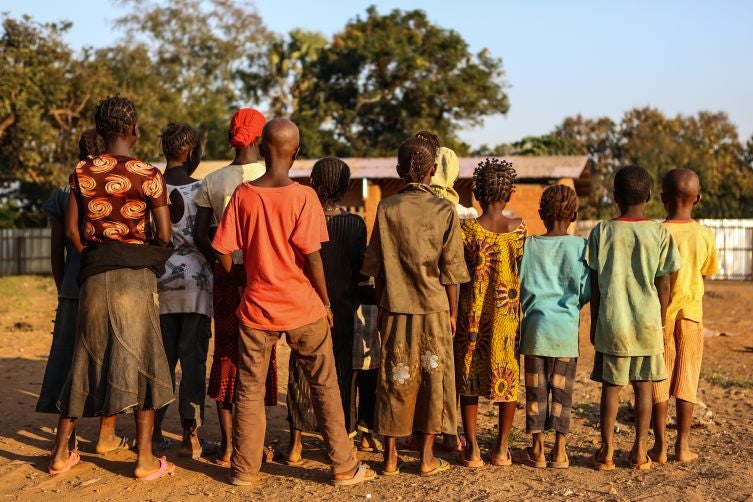Fighting to give new hope to the children of war
In the second special despatch for our Christmas appeal - which supports Unicef's work with child soldiers in the Central African Republic - the owner of The Independent speaks to charity workers trying to persuade rebel warlords to release captive children


Donate to our Appeal here, and bid in our auction here.
Aigbando, Central African Republic
It was clear when the truck appeared that this time the children were not going to be allowed to leave peacefully. The vehicle, which stopped near the cars which had brought Unicef’s negotiators to the rebel base, was filled with paramilitaries brandishing rocket-propelled grenades and Kalashnikovs.
Their commander strode forward to where those youngsters who were set to be released that day were waiting, in Unicef cars, to be ferried from the base – deep in the bush of Central African Republic’s north-east region – to the safety and security of the rehabilitation centre, a three-hour drive away. His bodyguards fanned out around him, an array of guns dripping from their camouflage uniforms.
For a brief moment we hoped he might be there to keep the promises he had made to demobilise. Already he had signed the paperwork to confirm that the children would not be re-recruited. In August his organisation had signed a peace treaty, promising to put down its weapons. One of the rebels’ representatives from the capital was with the Unicef team, supposedly there to ensure that promise was kept.
The moment of hope did not last. The commander started shouting orders. His men rounded on one member of the team, beating him around the face and throwing him against one of the charity’s cars.
While the Unicef negotiators pleaded for calm, a rebel forced open the door of a four-by-four emblazoned with the charity’s blue logo and dragged two girls out of it, on to the red dirt.
One was 14, the other only a little older. The 14-year-old had been given by the commander to one of his men as a ‘wife’, in reality no more than a sex slave to be abused. The family of this man now did not want her to be allowed to escape, nor the other to go with her. The commander’s followers pelted the girls with rubbish as they were pulled into a nearby building. Threats were shouted at the entire Unicef release team. The man who had been knocked to the ground was told that he would be hunted down and killed for the work he was trying to undertake for the children.
Brutal
Slowly, under the watchful eye of the assembled warlords, the Unicef cars retreated through the main gate. But they did take with them the one child whose release they had managed to secure, desperate to ferry him, at least, to the local rehabilitation centre, where the other boys and girls they had already liberated were waiting.
It was not the result they had hoped for. Previous visits had seen far more saved. Once, Unicef rescued 12 children in a single visit. This time, because of the stand-off at the end, only one child had been rescued – while the group had already moved most of its young combatants to a clearing 20 miles away so they could not be identified. The rebels did not want their ranks weakened by the loss of so many child soldiers at once.
Yet even that single child represented one life saved and transformed. And what our visit did expose was just how brutal the conditions are in which these youngsters are being held – and how extreme are the challenges facing those who work to release them. The encounter left no doubt about how essential it is that everything possible be done to try to secure these children’s freedom. That is why The Independent has chosen for its Christmas Appeal this year to work with the leading children’s charity, Unicef, to raise money for the vital work of rescuing these child soldiers.
“Today highlighted the grave reality that children face in the Central African Republic as a result of persistent armed conflict,” Mary Louise Eagleton, the Unicef Deputy Representative who had overseen the visit, told me after we had driven a safe distance. “The work we do to get children released is extremely challenging and unpredictable and requires relentless efforts and negotiation. Ultimately every child that gets out is a success and we cannot stop until every one has been removed from the rebel groups and is able to undergo a process to start to rebuild their lives.”
I was in the Central African Republic as a guest of Unicef to understand for myself the work being done to help children associated with armed groups there. It was a humbling experience to witness the bravery of the Unicef staff working in this former French colony, to see exactly how desperate the lives of those child soldiers are, and to hear from those already released about the deprivations they suffered.
One 16-year-old girl, whom I shall call Clemence as we cannot reveal her real name for her own protection, had escaped only two weeks ago after spending four years in the military camp. She made clear to me what those young women I had seen pulled from the Unicef car and kept at the camp would have been enduring.
“I have a lot of scars,” she said, gesturing to her thighs and back. “I was raped many times. If I did anything wrong I was tied up in a corner for several days at a time. I want to forget my past. I never want to see weapons again. Young women are precious. They should not suffer rape and violence.”
She had been recruited into the CPJP, the Convention of Patriots for Justice and Peace, which is one of a number of such groups battling for control of the diamond mines located throughout the north-eastern region of the Central African Republic.
In 2011 it seized control of the town of Aigbando, a settlement that had sprung up to house diamond miners and dealers. Since then Aigbando has been one of its main bases, the population forced to bend to the instruction of the men in uniform.
I had come to this town with Unicef to negotiate more children’s release. There was no escaping its extreme poverty: the houses built from mud bricks and with reed roofs, the sole road carved out of the dirt and potholed.
At its entrance stood a school. As we drove up, a militiaman casually walked among the primary-school children playing outside. He had an armed RPG resting on his shoulder and another rocket swaying from his right hand.
Soul rebels
I challenged the local CPJP commander on how he could behave in such a manner. “There is no security in this country,” he told me. “If there is no peace there is no hope of putting down our guns as others may attack us.”
He wore a pristine uniform and was sitting beside his senior officers on a line of wooden chairs near a papaya tree. His principal bodyguard stood behind him.
“We have to defend the people,” the general continued, smiling. “We want an agreement that everyone is free – that the government and people can live in freedom. Everyone should live without discrimination or fear.”
Later, I talked with the town’s deputy mayor. She told me local people had become so desperate since the men with guns arrived that they had resorted to living off wild forest fruits to survive. Later still, I saw the general emerge from his vehicle and oversee the removal of the two girls who had begged the Unicef negotiators to take them with them.
The Unicef programme in the Central African Republic seeks not only to secure the release of the estimated 2,500 child soldiers in the country but also to help reintegrate them into their communities. It does this through a network of transit centres where released children can be housed, receive medical treatment, be taught vocational skills if they are old enough to start work, and learn again what it is like to be surrounded by those who wish to help rather than exploit them.
The nearest transit centre to Aigbando is in Bria, the regional capital. It bears little resemblance to a Western youth centre. The beds are wooden bunks. The classrooms have bare walls. The play area is a dirt patch. But it is safe, and the staff are dedicated to helping heal the psychological wounds these children have received.
When our convoy returned from Aigbando with the boy whose release had been secured, the music played by the welcome party to greet him could be heard a hundred yards away. As the iron doors to the centre swung open, children rushed to the vehicle.
Many of them had lived and suffered and fought beside him during their years under the control of the CPJP. Now they gathered around him to invite him into his new home.
I recognised one of the children who led him towards the dancers as a boy I had talked to the previous day about his own experiences as a child soldier. He told me he had been only 14 when he was given a gun. In his life he had already been involved in at least five serious fights. “Those were hard attacks. Ones with deaths,” he told me.
Now he, the new arrival, and all the other children danced as African reggae boomed from speakers.
As I looked on I realised that, their faces caught in the fluorescent lamplight, all of them were smiling.

Join our commenting forum
Join thought-provoking conversations, follow other Independent readers and see their replies